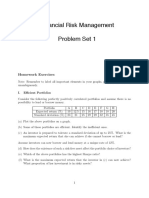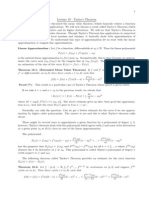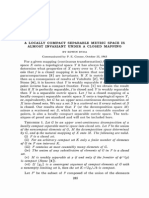Econ 252 Spring 2011 Problem Set 2
Econ 252 Spring 2011 Problem Set 2
Uploaded by
Tu ShirotaCopyright:
Available Formats
Econ 252 Spring 2011 Problem Set 2
Econ 252 Spring 2011 Problem Set 2
Uploaded by
Tu ShirotaCopyright
Available Formats
Share this document
Did you find this document useful?
Is this content inappropriate?
Copyright:
Available Formats
Econ 252 Spring 2011 Problem Set 2
Econ 252 Spring 2011 Problem Set 2
Uploaded by
Tu ShirotaCopyright:
Available Formats
Econ 252 Spring 2011
Econ 252 - Financial Markets Spring 2011 Professor Robert Shiller Problem Set 2
Problem Set 2
Professor Robert Shiller
Question 1 Consider the following three assets:
Asset Bs expected return is 8% and return standard deviation is 32%. Asset C is a risk-free asset with 2% return.
Asset As expected return is 5% and return standard deviation is 25%.
The correlation between assets A and B is -0.3. (a) Constructing a portfolio from assets A and B such that the expected return of the standard deviation of the portfolio. portfolio equals 7%, find the portfolio weights of assets A and B and compute the return
(b) Constructing a portfolio from assets A and B such that the expected return of the standard deviation of the portfolio.
portfolio equals 3%, find the portfolio weights of assets A and B and compute the return
(c) Constructing a portfolio from assets A and C such that the expected return of the return standard deviation of the portfolio.
portfolio equals 2.5%, find the portfolio weights of assets A and C and compute the
(d) Constructing a portfolio from assets A and C such that the expected return of the return standard deviation of the portfolio.
portfolio equals 10%, find the portfolio weights of assets A and C and compute the 1
Econ 252 Spring 2011 Question 2
Problem Set 2
Professor Robert Shiller
Consider the following two assets:
Asset As expected return is 4% and return standard deviation is 42%.
Asset Bs expected return is 1.5% and return standard deviation is 24%.
The correlation between assets A and B is 0.1. (a) Compute the expected return and the return standard deviation for a portfolio putting weight w on asset A and weight 1-w on asset B for w=-0.5, w=0.3, w=0.8, w=1.3. You now have six points on a portfolio frontier involving assets A and B. (b) Carefully draw a sketch of the portfolio frontier in a --diagram. Mark the three regions in which w is negative, between 0 and 1, and bigger than 1. Additionally, indicate the minimum variance portfolio.
Assume that the upper part of the portfolio frontier that you have just drawn represents the Efficient Portfolio Frontier of some set of assets that will not be specified any further. Tangency/Market Portfolio. Tangency/Market Portfolio. (c) Draw the tangency line associated with a risk-free return of 1%. Indicate the (d) Draw another tangency line associated with a risk-free return of 0%. Again, indicate the (e) Assume you want to minimize return standard deviation for given levels of expected return. If you need to construct a portfolio with expected return 5%, would you rather want to use the risk-free rate in part (c) or the one in part (d).
Econ 252 Spring 2011 Question 3
Problem Set 2
Professor Robert Shiller
Consider a Market Portfolio with 12% expected return and 20% return standard deviation. (a) If the Sharpe ratio of the market portfolio is 0.5, what is the risk-free rate of return? (b) Consider the following three portfolios on the tangency line: Portfolio 1 has 6.3% expected return. Portfolio 2 has 8.25% expected return. Portfolio 3 has 17.8% expected return.
Find the return standard deviation of each of the three portfolios.
(Hint: Use the fact that all portfolios are located on the tangency line.) In the context of the Mutual Fund Theorem, one is not able to specify the exact portfolio that an agent will choose on the Tangency Line, as long as one does not know the exact tradeoff between expected return and return standard deviation that this agent faces. the exact portfolio on the Tangency Line that will be optimal for this agent. u(portfolio) = -22. In the following, an explicit tradeoff for an agent will be specified. This will allow finding So, assume that the utility that an agent derives from any portfolio is given by That is, the utility of the portfolio is its expected return minus twice its variance. (c) Which of the three portfolios from part (b) will the agent with the above utility function choose? In fact, your answer is the portfolio that the agent will choose among all possible portfolios consisting of the risk-free asset and the market portfolio. QUESTION 3 CONTINUES ON THE NEXT PAGE.
Econ 252 Spring 2011
CONTINUATION OF QUESTION 3.
Problem Set 2
Professor Robert Shiller
(d) (This part is optional and not relevant for any of the exams.) expected return and the return variance of an arbitrary portfolio consisting of the riskfree asset and the Market Portfolio. Plug these expressions into the utility-function sure that you have found a maximum.) above and optimize with respect to w. Check the SOC (second-order condition) to make (Hint: Derive expressions, in terms of the weight w on the risk-free asset, for the Formally derive the optimality of the portfolio from part (c).
Econ 252 Spring 2011 Question 4
Problem Set 2
Professor Robert Shiller
Consider the following year-end prices of a hypothetical market index: Year 2004 2005 2006 2007 2008 2009 2010 Price 100 110 104.5 106.59 106.59 110.85 108.63
(a) Compute the expected (annual) return of the market index as the arithmetic average of the annual returns of the market index. Assume that the risk-free rate equals 0.75% and use the above market index as the Market
Portfolio.
(b) Assuming that the CAPM holds, what is the expected return of asset A whose beta equals 0.8? equals 3? (c) Again assuming that the CAPM holds, what is the expected return of asset B whose beta (d) What, according to the CAPM, is the beta of an asset C whose expected return equals 0.75% (that is, the risk-free rate in this problem)?
You might also like
- Advanced Portfolio Management: A Quant's Guide for Fundamental InvestorsFrom EverandAdvanced Portfolio Management: A Quant's Guide for Fundamental InvestorsNo ratings yet
- 4 - Problem - Set FRM - PS PDFDocument3 pages4 - Problem - Set FRM - PS PDFValentin IsNo ratings yet
- #1 - Midterm Self Evaluation SolutionsDocument6 pages#1 - Midterm Self Evaluation SolutionsDionizioNo ratings yet
- F 17 As 1Document3 pagesF 17 As 1Massimo FerranteNo ratings yet
- Awesome OscillatorDocument4 pagesAwesome OscillatoramitNo ratings yet
- Assig 2Document7 pagesAssig 2Katie CookNo ratings yet
- Week 3 Tutorials - PDF PDFDocument9 pagesWeek 3 Tutorials - PDF PDFDaniel NgoNo ratings yet
- DTU406 - Practice Exam PDFDocument8 pagesDTU406 - Practice Exam PDFLý Minh TânNo ratings yet
- DTU406 - Mock ExamDocument8 pagesDTU406 - Mock ExamXuân MaiNo ratings yet
- Finance 1 For IBA - Tutorial 5: Pranav Desai Joren Koëter Lingbo ShenDocument15 pagesFinance 1 For IBA - Tutorial 5: Pranav Desai Joren Koëter Lingbo ShenLisanne Ploos van AmstelNo ratings yet
- Training ExercisesDocument4 pagesTraining ExercisesnyNo ratings yet
- Prob Set 4Document3 pagesProb Set 4ebrahimnejad64No ratings yet
- PS 4Document7 pagesPS 4Gilbert Ansah YirenkyiNo ratings yet
- FE-Unit 1, 2 QuestionsDocument4 pagesFE-Unit 1, 2 Questionsarya.enactusdcacNo ratings yet
- HW03Document7 pagesHW03lhbhcjlyhNo ratings yet
- FM Assgt 3Document3 pagesFM Assgt 3Hello MinecraftNo ratings yet
- Aps502h1 20209 6316201532472020Document4 pagesAps502h1 20209 6316201532472020HannaNo ratings yet
- Act7 2Document4 pagesAct7 2Helen B. EvansNo ratings yet
- Ac.f215 Exam 2018-2019 PDFDocument6 pagesAc.f215 Exam 2018-2019 PDFWilliam NogueraNo ratings yet
- 23 Mock 2010Document5 pages23 Mock 2010Jie XiongNo ratings yet
- ps3 2010Document6 pagesps3 2010Ives LeeNo ratings yet
- Tutorial 8 QuestionsDocument2 pagesTutorial 8 Questionsk63.2412580003No ratings yet
- Cov (R, R) = β β σ Cov (R, R) = 0.8 *0.9*0.35^2 Cov (R, R) =0.07717Document5 pagesCov (R, R) = β β σ Cov (R, R) = 0.8 *0.9*0.35^2 Cov (R, R) =0.07717killerNo ratings yet
- Capital Asset Pricing Model HomeworkDocument14 pagesCapital Asset Pricing Model Homeworktonynugan100% (1)
- Chap008 Text Bank (1) SolutionDocument9 pagesChap008 Text Bank (1) SolutionpauljohnsharpNo ratings yet
- BUSN 20400 Midterm Examination Winter 2021: Booth Honor Code and Booth Standards of ScholarshipDocument6 pagesBUSN 20400 Midterm Examination Winter 2021: Booth Honor Code and Booth Standards of ScholarshipPatrick ZhouNo ratings yet
- IF2207 - Problems - 6Document3 pagesIF2207 - Problems - 6satyavaniNo ratings yet
- Tutorial-2 212 Mba 680 SolutionsDocument9 pagesTutorial-2 212 Mba 680 SolutionsbillyNo ratings yet
- FM423 2017Document9 pagesFM423 2017tonggennnNo ratings yet
- FRM Part I - Full Length Test 3Document37 pagesFRM Part I - Full Length Test 3pradeep johnNo ratings yet
- Assignment1 2020 PDFDocument8 pagesAssignment1 2020 PDFmonalNo ratings yet
- Investment (Index Model)Document29 pagesInvestment (Index Model)Quoc Anh NguyenNo ratings yet
- 1 19Document8 pages1 19Yilei RenNo ratings yet
- Markowitz Portfolio TheoryDocument13 pagesMarkowitz Portfolio TheoryManisha BhoiNo ratings yet
- Sample Exam QuestionsDocument16 pagesSample Exam QuestionsMadina SuleimenovaNo ratings yet
- Chapter 8 QuestionsDocument7 pagesChapter 8 QuestionsVinay YevatkarNo ratings yet
- Handout FIN F313Document5 pagesHandout FIN F313Shubham JainNo ratings yet
- Problem Set 1Document3 pagesProblem Set 1ikramraya0No ratings yet
- Tutorial Questions On Fundamrntal of Investment Analysis 2024Document10 pagesTutorial Questions On Fundamrntal of Investment Analysis 2024Blaise KrisNo ratings yet
- Problem Set 5 Financial Management - Financial AnalysisDocument4 pagesProblem Set 5 Financial Management - Financial AnalysisValentin IsNo ratings yet
- RevisionDocument5 pagesRevisionMaryam YusufNo ratings yet
- Seminar 2 Pricing of Risky Assets SolutionsDocument8 pagesSeminar 2 Pricing of Risky Assets Solutionslynn871004No ratings yet
- Seminar 3 Midterm SOLUTIONSDocument10 pagesSeminar 3 Midterm SOLUTIONSlynn871004No ratings yet
- FIE400E 2018 SpringDocument9 pagesFIE400E 2018 SpringSander Von Porat BaugeNo ratings yet
- Revision Questions and Classwork 8Document8 pagesRevision Questions and Classwork 8Sams HaiderNo ratings yet
- Chapter 11Document7 pagesChapter 11NguyenThiTuOanhNo ratings yet
- Reading 50 Portfolio Risk and Return Part II AnswersDocument46 pagesReading 50 Portfolio Risk and Return Part II AnswersK59 Nguyen Thao LinhNo ratings yet
- Fin 367 Sample Problems Chapters 10-11, 13-16Document21 pagesFin 367 Sample Problems Chapters 10-11, 13-16Nicholas Jack KhooNo ratings yet
- J2FIN: Problem Sheet 9: DR Jia ShaoDocument4 pagesJ2FIN: Problem Sheet 9: DR Jia Shaolxz1160915566No ratings yet
- Exercise 6Document2 pagesExercise 6Nhu HuynhNo ratings yet
- Exercise 7Document2 pagesExercise 7Nhu HuynhNo ratings yet
- There Are 20 Questions in This Part. Please Choose ONE Answer For Each Question. Each Question Is Worth 0.2 PointsDocument8 pagesThere Are 20 Questions in This Part. Please Choose ONE Answer For Each Question. Each Question Is Worth 0.2 PointsThảo Như Trần NgọcNo ratings yet
- 313 Practice Exam III 2015 Solution 2Document9 pages313 Practice Exam III 2015 Solution 2Johan JanssonNo ratings yet
- Financial Management 2: Prepared By: Eunice Meanne B. SiapnoDocument26 pagesFinancial Management 2: Prepared By: Eunice Meanne B. SiapnoJesa SinghbalNo ratings yet
- Chapters 12 & 13 Practice Problems: Economy Probability Return On Stock A Return On Stock BDocument4 pagesChapters 12 & 13 Practice Problems: Economy Probability Return On Stock A Return On Stock BAnsleyNo ratings yet
- Chap 08Document36 pagesChap 08George MartinNo ratings yet
- APS 1 QuestionsDocument12 pagesAPS 1 Questions980921kill123No ratings yet
- Final Exam Sample 1 NOsolutions1Document14 pagesFinal Exam Sample 1 NOsolutions1alexandre.stalensNo ratings yet
- Tutorial 5 - SolutionsDocument8 pagesTutorial 5 - SolutionsHa PhiNo ratings yet
- Breakouts For Beginners PDFDocument19 pagesBreakouts For Beginners PDFTu ShirotaNo ratings yet
- Lecture 10 Taylor's Theorem PDFDocument2 pagesLecture 10 Taylor's Theorem PDFTu ShirotaNo ratings yet
- TaylorDocument5 pagesTaylorpazrieNo ratings yet
- Package SQLDF': R Topics DocumentedDocument13 pagesPackage SQLDF': R Topics DocumentedTu ShirotaNo ratings yet
- Taylor's Theorem in One and Several VariablesDocument4 pagesTaylor's Theorem in One and Several VariablesTu ShirotaNo ratings yet
- Taylor's TheoremDocument4 pagesTaylor's TheoremTu ShirotaNo ratings yet
- Pronunciation of Mathematical ExpressionsDocument6 pagesPronunciation of Mathematical ExpressionsTu ShirotaNo ratings yet
- A Locally Compact Separable Metric Space Is Almost Invariant Under A Closed MappingDocument2 pagesA Locally Compact Separable Metric Space Is Almost Invariant Under A Closed MappingTu ShirotaNo ratings yet
- On Open and Closed Morphisms Between Semialgebraic Sets: R M (X R), - . - , G R (X, - . - , X R IsDocument13 pagesOn Open and Closed Morphisms Between Semialgebraic Sets: R M (X R), - . - , G R (X, - . - , X R IsTu ShirotaNo ratings yet
- Pedersen2013monte CarloDocument113 pagesPedersen2013monte CarloTu ShirotaNo ratings yet
- Bến Thành Market is a large marketplace in the downtown area ofDocument1 pageBến Thành Market is a large marketplace in the downtown area ofTu ShirotaNo ratings yet
- Availability BiasDocument15 pagesAvailability Biasmanoj_mmmNo ratings yet
- MAFIN AssignmentDocument2 pagesMAFIN AssignmentEms DelRosario100% (3)
- A Study On Futures and Potions: Project Submitted in Partial Fulfillment For The Award of The Degree ofDocument57 pagesA Study On Futures and Potions: Project Submitted in Partial Fulfillment For The Award of The Degree offeroz5105No ratings yet
- Siva Bharathi G (20MBAR0130) SIP REPORT (Hard Copy)Document42 pagesSiva Bharathi G (20MBAR0130) SIP REPORT (Hard Copy)chakradhar pmNo ratings yet
- Accounting Setup in Oracle General LedgerDocument3 pagesAccounting Setup in Oracle General LedgerAshwinNo ratings yet
- Anthony Bolton The GuDocument2 pagesAnthony Bolton The GushanziyyNo ratings yet
- Report FMDocument2 pagesReport FMKristine MartinezNo ratings yet
- Darvas Technical Filter Plus PDFDocument32 pagesDarvas Technical Filter Plus PDFAlvinNo ratings yet
- Artikel Capital MarketDocument2 pagesArtikel Capital MarketDianaNo ratings yet
- Accounting CONCEPTS Multiple Choice QuestionsDocument7 pagesAccounting CONCEPTS Multiple Choice Questionspatsjit50% (2)
- Ifm Chapter 6 Financial OptionsDocument47 pagesIfm Chapter 6 Financial Optionsminhhien222No ratings yet
- 050c Nelson Freeburg On Developing The Perfect Trading SystemDocument9 pages050c Nelson Freeburg On Developing The Perfect Trading Systembeetho1990100% (2)
- Nifty Technical AnalysisDocument136 pagesNifty Technical Analysisapi-3728932No ratings yet
- AccountsDocument59 pagesAccountsrajat0% (1)
- A Simple Day Trading StrategyDocument15 pagesA Simple Day Trading Strategyzooor100% (3)
- List of ProjectDocument6 pagesList of ProjectPradeep BiradarNo ratings yet
- 2018 Exam Ifm Sample Questions PDFDocument89 pages2018 Exam Ifm Sample Questions PDFSujith GopinathanNo ratings yet
- SO-DR GroupDocument13 pagesSO-DR GroupKunalSehraNo ratings yet
- Direct Tax-Chit FundDocument27 pagesDirect Tax-Chit FundAbirami VasudevanNo ratings yet
- Modern Portfolio TheoryDocument14 pagesModern Portfolio Theoryquetec100% (1)
- BankDocument25 pagesBankahmed100% (2)
- Investing For BeginnersDocument10 pagesInvesting For BeginnersAnonymous YkDJkSqNo ratings yet
- ACI Dealing Certificate New Version Syllabus 27 Jul 2020Document15 pagesACI Dealing Certificate New Version Syllabus 27 Jul 2020Oluwatobiloba OlayinkaNo ratings yet
- Emerging Trends in Corporate Governance PracticesDocument9 pagesEmerging Trends in Corporate Governance PracticesDr-Rahat KhanNo ratings yet
- Philsteel Holdings Corp.: Philsteel Tower, 140 Amorsolo ST., Legaspi Village Makati CityDocument2 pagesPhilsteel Holdings Corp.: Philsteel Tower, 140 Amorsolo ST., Legaspi Village Makati CityShainaNo ratings yet
- Finance Notes at Mba FinanceDocument40 pagesFinance Notes at Mba FinanceBabasab Patil (Karrisatte)No ratings yet
- Swing Trading With Heiken Ashi and StochsDocument6 pagesSwing Trading With Heiken Ashi and Stochsshreya0181No ratings yet
- Tips For Investing in Resources Companies by Casey ResearchDocument8 pagesTips For Investing in Resources Companies by Casey ResearchGold Silver Worlds100% (2)



































































































